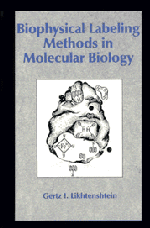Book contents
- Frontmatter
- Contents
- Preface
- Abbreviations
- 1 The method of spin labeling
- 2 Double-labeling techniques
- 3 Fluorescent labeling methods
- 4 Triplet labeling methods
- 5 Mössbauer spectroscopy, electron scattering, and other labeling methods
- 6 Studies of proteins and enzymes: structure, dynamics, and mechanism of action
- 7 Structure and dynamics of membranes
- 8 Nucleic acids and other biological systems: biological assays
- Conclusion
- References
- Index
3 - Fluorescent labeling methods
Published online by Cambridge University Press: 29 January 2010
- Frontmatter
- Contents
- Preface
- Abbreviations
- 1 The method of spin labeling
- 2 Double-labeling techniques
- 3 Fluorescent labeling methods
- 4 Triplet labeling methods
- 5 Mössbauer spectroscopy, electron scattering, and other labeling methods
- 6 Studies of proteins and enzymes: structure, dynamics, and mechanism of action
- 7 Structure and dynamics of membranes
- 8 Nucleic acids and other biological systems: biological assays
- Conclusion
- References
- Index
Summary
Luminescent dyes have been routinely used in biochemistry as indicators of acidity, in biochemical assays, in histometry, and in other areas. For the past 30–40 years luminescent labels have found wide application in the solution of a number of structural and dynamic problems in enzyme and membrane systems (Vladimirov & Dobretsov 1980; Lakowicz 1983; Hoffman & Restall 1984; Waggoner 1986; Dobretsov 1989).
The areas of application for luminescent labels are as wide-ranging as are those for spin labels, e.g., determination of local acidity and polarity of objects under study and estimation of the parameters of micro viscosity and molecular dynamics from data on the rotational and translational diffusion of labels. The methods of luminescent labels and probes allow measurements of transmembrane and surface potentials, studies of localization of charged and hydrophobic portions, and estimation of the distances between discrete centers and the depth of immersion into the biological matrix. Luminescent chromophores, like spin labels, can serve as “microscopic seismic stations,” following subtle changes in the local conformation during the functioning of biological objects.
In this chapter the physicochemical principles and the scope of the method of luminescent labels and probes will be briefly considered. Examples of their application to studies of biological objects will be given in Chapters 6–8.
General
Absorption spectra
The phenomenon of absorption of electromagnetic radiation in the ultraviolet (UV) and visible regions of optical spectra results from the discreteness of the energy levels in molecules.
- Type
- Chapter
- Information
- Biophysical Labeling Methods in Molecular Biology , pp. 80 - 115Publisher: Cambridge University PressPrint publication year: 1993



